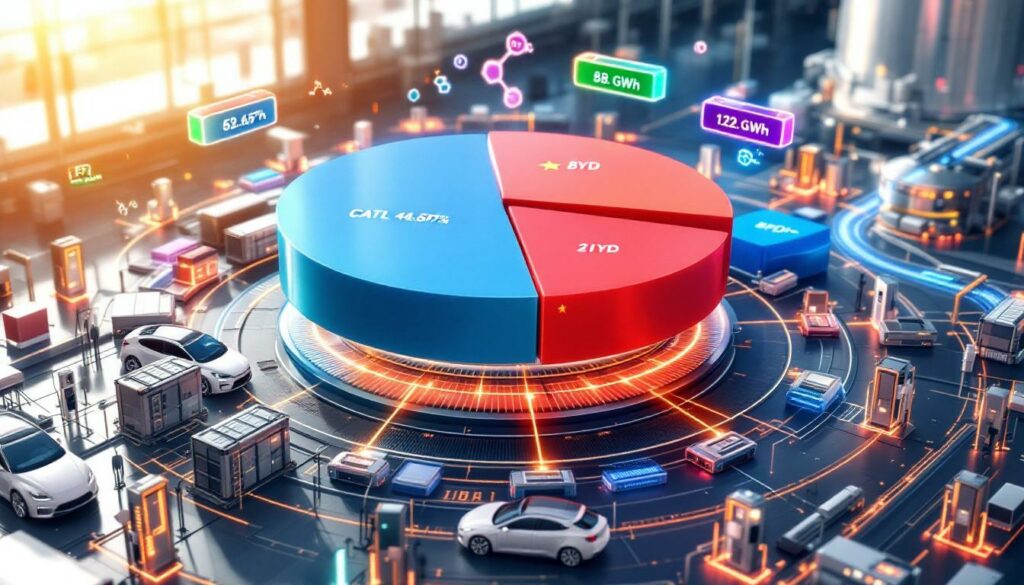China's EV Battery Market in June 2025: Trends and Market Share Analysis
China's electric vehicle battery sector continues its impressive expansion, with installation volumes reaching 58.2 GWh in June 2025. This represents a substantial 35.9% year-on-year increase and a 1.9% rise from May's figures. The market remains dominated by a few key players, with shifting dynamics between battery technologies reflecting broader industry trends.
What's Driving China's EV Battery Market Growth?
The remarkable growth in China's EV battery market can be attributed to several interconnected factors that continue to propel the industry forward. With total installation volume reaching 58.2 GWh in June 2025, the sector shows robust expansion despite global economic challenges.
Key Market Growth Indicators
The strength of China's EV battery market is evident in its impressive statistics:
- Total installation volume: 58.2 GWh (June 2025)
- Year-on-year growth: 35.9%
- Month-on-month growth: 1.9%
- Production capacity: 129.2 GWh (up 51.4% year-on-year)
- Export volume: 15.8 GWh
The substantial gap between production capacity (129.2 GWh) and domestic installation (58.2 GWh) highlights China's strategic positioning as both a domestic supplier and global exporter of EV batteries. This production surplus enables manufacturers to meet rising international demand while maintaining buffer capacity for domestic market fluctuations.
Government Policy Support
A significant driver behind China's EV battery growth is the government's consistent policy support. China's dual-credit policy, which mandates automakers to produce a certain percentage of new energy vehicles, continues to create steady demand for batteries. Additionally, the extension of purchase tax exemptions for EVs through 2025 has maintained consumer interest in electric vehicles.
Industry insight: The significant production-installation gap of approximately 71 GWh represents China's strategic buffer to absorb supply chain disruptions while maintaining export commitments—a lesson learned from pandemic-era shortages.
Technological Advancements
Chinese battery manufacturers have made substantial improvements in energy density, charging speeds, and cycle life, making EVs increasingly attractive to consumers. CATL's latest cell-to-pack technology has eliminated modules entirely, boosting energy density by up to 13% compared to 2024 versions, while reducing costs. Recent Chinese battery recycling breakthrough technologies have also contributed to a more sustainable industry ecosystem.
Cost Reductions
Battery costs have continued their downward trajectory, with average pack prices falling below $100/kWh for LFP batteries in early 2025. This price decline has significantly improved the total cost of ownership equation for EV consumers, accelerating adoption rates and transforming the battery‐metals investment landscape.
Who Are the Market Leaders in China's EV Battery Industry?
The Chinese EV battery market continues to be dominated by a few major manufacturers, with CATL maintaining its commanding lead while competitors jockey for position.
Top 5 Battery Manufacturers by Market Share
| Manufacturer | Installation Volume (GWh) | Market Share (%) | Change from May 2025 |
|---|---|---|---|
| CATL | 25.41 | 43.67% | +0.80% |
| BYD | 12.49 | 21.47% | -1.02% |
| CALB | 4.39 | 7.55% | +0.02% |
| Gotion High-tech | 2.92 | 5.02% | Not specified |
| Eve Energy | 2.53 | 4.35% | Replaced Sunwoda |
The top five manufacturers collectively account for approximately 82% of the market, demonstrating the highly consolidated nature of China's EV battery industry. This concentration of market power has created significant barriers to entry for new competitors.
CATL's Market Dominance
CATL continues to strengthen its position as the undisputed market leader with 43.67% market share in June, an increase of 0.8 percentage points from May's 42.87%. The company's dominance spans both battery chemistries:
- 71.23% share in ternary battery installations
- 37.46% share in LFP battery installations
CATL's success can be attributed to its massive economies of scale, extensive R&D investments, and strong relationships with both domestic and international automakers. The company's Ningde headquarters and manufacturing complex now exceeds 100 GWh in annual capacity, making it the world's largest battery production site.
BYD's Position
Despite maintaining its second-place ranking, BYD experienced a slight decline in market share, dropping to 21.47% in June from 22.49% in May. This represents a decrease of 1.02 percentage points. BYD remains a dominant force in the LFP battery segment with a 26.34% market share.
BYD's unique vertical integration model—manufacturing both batteries and vehicles—provides the company with significant cost advantages and supply chain security. The company's proprietary Blade Battery technology continues to win contracts with external automakers, including Tesla for its Model 3 production in Shanghai.
Rising Competitors
CALB maintained its third-place position with 7.55% market share, a slight increase of 0.02 percentage points from May. The company's focus on high-quality manufacturing and strategic partnerships with emerging EV brands has helped it carve out a stable position in the market.
Gotion High-tech and Eve Energy round out the top five, with Eve Energy notably displacing Sunwoda in the rankings. Eve Energy's rise reflects its successful expansion into prismatic cell technology and growing partnerships with European automakers.
How Are Battery Technologies Evolving in China's EV Market?
The Chinese EV battery market continues to show a strong preference for LFP (lithium iron phosphate) technology, though ternary lithium batteries maintain an important market position.
LFP Battery Dominance
LFP batteries continue to dominate the Chinese market:
| Metric | LFP Batteries | Percentage |
|---|---|---|
| Installation volume | 47.4 GWh | 81.5% of total |
| Year-on-year growth | +49.7% | – |
| Month-on-month growth | +1.9% | – |
| Production volume | 99.5 GWh | 77% of total production |
The preference for LFP chemistry in China stems from several factors:
- Cost efficiency: LFP batteries typically cost 20-30% less than ternary batteries
- Safety profile: Lower thermal runaway risk compared to nickel-based chemistries
- Resource security: Reduced dependence on imported nickel and cobalt
- Cycle life: Superior longevity with 3,000+ cycles versus 1,000-2,000 for typical ternary batteries
- Cold weather improvements: New LFP formulations have significantly reduced performance degradation in sub-zero temperatures
Recent advances in LFP technology have addressed the chemistry's traditional energy density limitations. CATL's M3P batteries (modified LFP) now achieve energy densities approaching 200 Wh/kg, making them viable for most passenger vehicle applications.
Ternary Battery Performance
Ternary lithium batteries hold a smaller but significant market share:
| Metric | Ternary Batteries | Percentage |
|---|---|---|
| Installation volume | 10.7 GWh | 18.4% of total |
| Year-on-year change | -3.4% | – |
| Month-on-month growth | +2.0% | – |
| Production volume | 29.5 GWh | 23% of total production |
The year-on-year decline of 3.4% in ternary battery installations highlights the shift toward LFP chemistry. However, the modest month-on-month growth of 2.0% suggests ternary batteries retain important applications where higher energy density is critical.
Ternary batteries continue to dominate in:
- Premium electric vehicles requiring maximum range
- Performance EVs where weight reduction is paramount
- Export markets where extreme cold weather performance is essential
Market Leaders by Battery Chemistry
Ternary Battery Market Leaders:
- CATL: 71.23% market share
- CALB: 10.91% market share
- LG Energy Solution: 8.76% market share
LFP Battery Market Leaders:
- CATL: 37.46% market share
- BYD: 26.34% market share
- CALB: 6.80% market share
The presence of South Korean manufacturer LG Energy Solution among the top ternary battery providers highlights the technology's international competitive landscape. LG's position is primarily built on partnerships with joint-venture automotive operations in China.
Emerging Battery Technologies
While not yet reflected in significant installation volumes, several emerging battery technologies are advancing through R&D and pilot production phases:
- Sodium-ion batteries: CATL and BYD have announced mass production timelines for late 2025, promising to reduce lithium dependency
- Semi-solid state cells: Several manufacturers are introducing higher silicon content anodes and composite electrolytes, improving energy density
- LFP cathode modifications: Doping with manganese and other elements to improve performance characteristics
These advances in battery technology are complemented by Australia's lithium industry innovations which are helping to secure critical mineral supply chains for global manufacturers.
What's Happening in China's Battery Production and Export Sectors?
China's battery production capacity significantly exceeds its domestic installation volume, positioning the country as a major global supplier of EV batteries.
Production Capacity
- Total battery production in June: 129.2 GWh
- Year-on-year growth: 51.4%
- Month-on-month growth: 4.6%
This substantial production capacity reflects China's strategic investment in battery manufacturing infrastructure. Major production hubs include:
- Fujian Province: CATL's headquarters and largest manufacturing base
- Guangdong Province: BYD and CALB facilities
- Jiangsu Province: Gotion High-tech's production center
- Sichuan Province: Emerging battery manufacturing cluster
The production-installation gap of approximately 71 GWh represents available capacity for exports and inventory building. This buffer provides manufacturers flexibility to manage global supply chain challenges while maintaining delivery commitments.
Battery Exports
China exported 15.8 GWh of power batteries in June 2025, comprising:
- Ternary batteries: 9.0 GWh (57% of exports)
- LFP batteries: 6.8 GWh (43% of exports)
This export volume represents approximately 27% of China's total battery production, highlighting the country's significant role in global EV battery supply chains.
Interestingly, while LFP batteries dominate domestic installations (81.5%), ternary batteries constitute the majority of exports (57%). This reflects differing preferences in international markets, where higher energy density often takes priority over cost considerations.
Manufacturing Efficiency Improvements
Chinese battery manufacturers have achieved significant improvements in production efficiency, with average yields now exceeding 95% for mature cell designs. Advanced manufacturing techniques, including:
- AI-powered quality control systems
- Fully automated cell assembly
- Precision electrode coating technologies
- Digital twin process optimization
These innovations have contributed to China's global cost leadership in battery manufacturing, with production costs approximately 15-20% lower than European or North American facilities.
How Does China's Battery Market Compare Globally?
China maintains a dominant position in the global EV battery market, with its top manufacturers holding significant worldwide market share.
Global Market Position (January-May 2025)
- CATL global market share: 38.1%
- BYD global market share: 17.4%
- Combined CATL and BYD global share: 55.5%
- Total global installations (CATL + BYD): 222.7 GWh
This demonstrates China's continued leadership in the global EV battery industry, with its top two manufacturers controlling over half the worldwide market. The growing EV impact on mining operations worldwide underscores the importance of China's battery manufacturing capabilities.
International Expansion
Chinese battery manufacturers have aggressively expanded manufacturing beyond domestic borders:
- CATL's European operations: The Erfurt, Germany facility now produces 30 GWh annually, supplying European automakers
- BYD's Southeast Asian hub: Thailand manufacturing center exports to Europe and Australia
- CALB's North American plans: Construction underway on U.S. facility to comply with IRA requirements
This international expansion helps Chinese manufacturers navigate geopolitical challenges, including tariffs and local content requirements in major markets.
Technology Transfer Considerations
The global expansion of Chinese battery manufacturers has raised concerns about technology transfer and intellectual property protection. Joint ventures and licensing agreements between Chinese battery makers and international partners require careful balancing of competitive advantages with collaborative opportunities.
What Are the Future Trends for China's EV Battery Market?
Several key trends are emerging in China's EV battery landscape:
Increasing Production Capacity
The significant gap between production (129.2 GWh) and domestic installation (58.2 GWh) indicates China's strategic positioning to meet both domestic and international demand. Major manufacturers have announced capacity expansion plans that would add approximately 400 GWh of additional annual production by 2027.
Export Growth Potential
With exports currently at 15.8 GWh, there remains substantial capacity to increase international shipments as global EV adoption accelerates. However, growing protectionist policies in Europe and North America may limit export growth to these regions, shifting focus to emerging markets in Southeast Asia, Latin America, and the Middle East.
Technology Evolution
While LFP batteries dominate the market with 81.5% share, the continued presence of ternary batteries (18.4%) suggests manufacturers are maintaining technological diversity to address different vehicle requirements. The industry is witnessing increased chemistry specialization:
- Urban vehicles: LFP dominance for affordability and safety
- Premium vehicles: Nickel-rich ternary for maximum range
- Commercial vehicles: LFP for longevity and cost-effectiveness
- Two-wheelers: Emerging sodium-ion solutions for cost-sensitive applications
The growing demand for energy transition materials is creating new supply chain dynamics that Chinese manufacturers must navigate.
Market Consolidation
The top five manufacturers control approximately 82% of the market, indicating a consolidated industry structure with high barriers to entry for new competitors. This concentration may increase further as smaller players struggle to match the economies of scale and R&D investments of market leaders.
Vertical Integration
Battery manufacturers are increasingly moving up and down the supply chain:
- Upstream: Securing lithium, nickel, and cobalt mining rights
- Downstream: Partnering directly with automakers on vehicle-specific solutions
This vertical integration helps manage raw material costs and ensures stable supply chains amid growing global competition for battery minerals.
Recycling Ecosystem Development
As the first generation of mass-market EVs reaches end-of-life, battery recycling is becoming increasingly important. China's policy requiring battery manufacturers to establish recycling networks is driving investment in recovery technologies. Current recycling processes can recover:
- 95%+ of cobalt and nickel
- 85%+ of lithium
- 90%+ of manganese
These recovered materials are increasingly being incorporated into new battery production, reducing raw material costs and environmental impact.
FAQ: China's EV Battery Market
What factors are driving the growth of China's EV battery market?
China's EV battery market growth is fueled by strong government support for electric vehicle adoption, significant investments in battery manufacturing capacity, technological advancements improving battery performance and reducing costs, and growing consumer demand for electric vehicles both domestically and globally.
Why are LFP batteries more popular than ternary batteries in China?
LFP batteries have gained popularity in China due to their lower cost, improved safety profile, longer cycle life, and elimination of cobalt (reducing supply chain risks). While they typically offer lower energy density than ternary batteries, recent technological improvements have made them suitable for most passenger vehicle applications.
How is China's battery export strategy affecting global EV markets?
China's battery exports are accelerating global EV adoption by providing cost-competitive, high-quality batteries to international automakers. This is enabling more affordable electric vehicles worldwide while strengthening China's position in the global automotive supply chain.
What challenges does China's battery industry face?
Despite its dominant position, China's battery industry faces challenges including raw material supply constraints, increasing international competition, potential trade barriers in key markets, and the need to continually advance technology to maintain its competitive edge.
Further Exploration:
Readers interested in learning more about China's EV battery market can also explore related educational content available on CnEVPost and [
Ready to Get Ahead of the Next Big Mineral Discovery?
Don't miss a single significant ASX mineral discovery—try Discovery Alert's proprietary Discovery IQ model that transforms complex mineral data into actionable investment insights. Explore Discovery Alert's dedicated discoveries page to understand how major discoveries have historically delivered substantial market returns.




